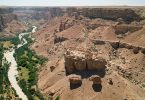By Tamjid Alkohali
Tarim is one of the most beautiful historic towns in Yemen. It is situated in Wadi Hadhramout in South Yemen. Because of its historical and scientific importance, it was chosen to be the capital of Islamic culture in 2010. It’s a unique model for mud architecture. It has many huge mud palaces that are unparalleled either in Yemen or even at the regional level.
Each palace in Tarim has a name. The most famous is Al-Ranad Palace that is considered the oldest. It was built before modern Islam. Dr. Nasser Alkadiri, Professor of Architectural Design at the Ibb University said that Al-Ranad was taken by Hussein bin Salama, one of Zaidi rulers, as the headquarters for him and renewed it in 1203. The last restoration of the palace was in the era of Tarim’s ruler, Mohammed bin Mohsen Al Kathiri, in 1938.
However, Al-Ranad Palace was restored by the Minister of Culture in 2010 after Tarim was announced as the capital of Islamic culture. The restoration cost the government tens of millions and it was preparing it to be a museum for all manuscripts, popular heritage, and the old crafts of the town.
Unfortunately, the palace was turned from a cultural center to an administrative headquarters of Tarim’s local council, which led to sparking citizens’ anger, but this anger did nothing and the palace is still the headquarters of the local authority until today.
The Director of the General Organization for Maintaining Historic Towns, Hassan Aideed, explained that it was very suitable to make the palace a culture center to hold cultural events, but now it’s administrative offices. The Culture Office in Tarim took a part of it and the local authority took the part that was built recently, while the west part of the palace is closed.
“Compared with the importance of the palace, the local authority didn’t do its duties and didn’t implement any development projects, except some of the projects that have been implemented with a few celebrations,” Aideed added.
Despite the marginalization, the palace remains a legend in the mud construction and tale of beauty without end. It is filled with decorations that adorn the outside and inside as well as a big gate that makes people feel like they are entering a historical city and not a palace.
Tarim’s citizens are still looking forward to rehabilitating the palace and making it a cultural center that reflects the great cultural and civilizational heritage of this ancient city so that all the world can learn about the historical importance of Tarim.



